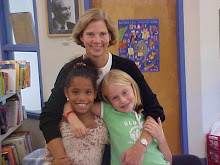Today in the NY Times, Laura Pappano, an education journalist writes about Learning to Think Like a Computer. It has become super popular lately to learn computer programming in college - and we see the excitement in elementary and middle school with robotics, Scratch and other programming activities.
Programming demystifies computing in many ways and gives kids practice in sequencing - the step by step brain work that is required to program successfully. "It's the idea of abstraction," Pappano quotes in her article. "It requires recognizing patterns and distilling complexity into a precise, clear summary,"
I see it in action in school through the intensity that kids bring to robotics - the perseverance they develop and the whoop of joy when they get the result they are looking for. They often work together, too and get a lot of practice collaborating when they are designing a 3D prosthetic limb for an amputee or adding voices to a life-story animation.
On days that we have after school robotics club, kids often come to show me what they've accomplished: in the photo above, a second and a third grader got their robot to stop at each color line and say "red", "blue"or "yellow". But it skipped saying "green"! Oh well - they weren't deterred - they went running back to the drawing board to try again.





















































